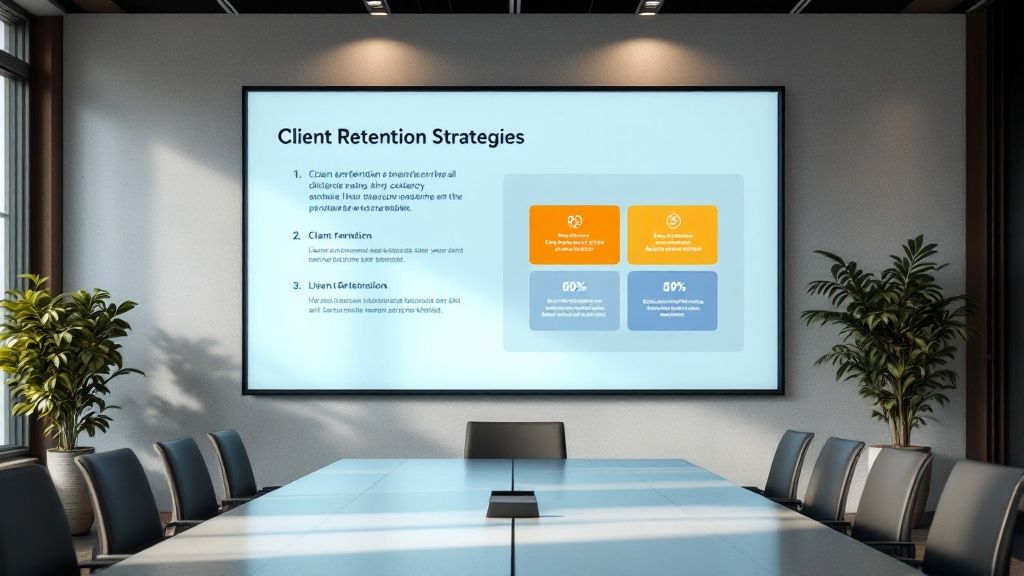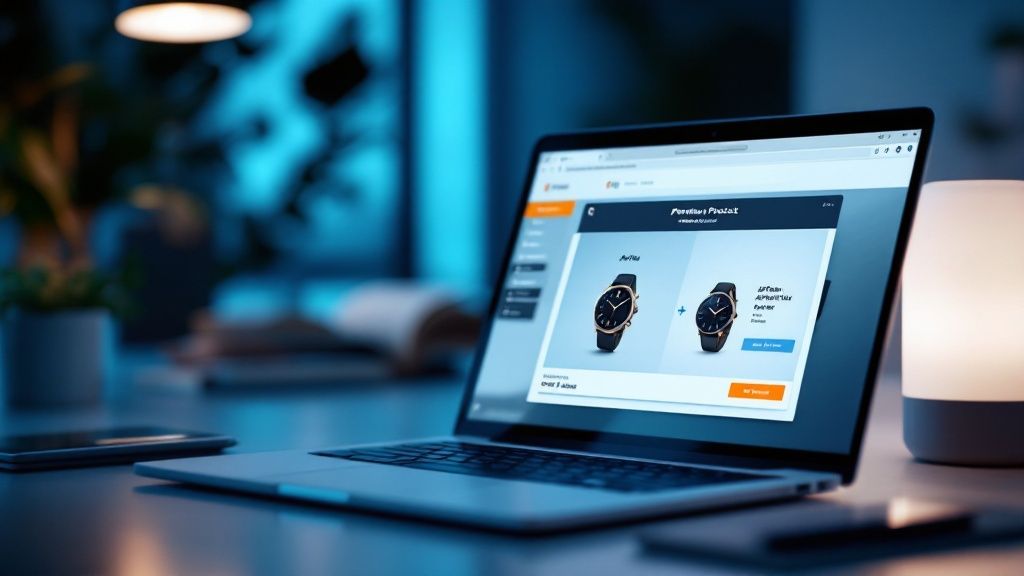Client Retention Metrics: The Advanced Guide to Measuring and Improving Customer Success
January 23, 2025

Understanding the Strategic Impact of Client Retention Metrics

The ability to keep customers coming back is crucial for any successful business. Client retention metrics help you measure and improve customer loyalty while giving you concrete data about the health of your customer relationships. When you track these numbers consistently, you can spot trends early and take action before small issues become major problems.
Why Client Retention Metrics Matter
It costs 5-25 times more to acquire a new customer than to keep an existing one. This simple fact makes focusing on retention a smart business decision. Your current customers already know and trust your brand, making them more likely to buy again and recommend you to others. For instance, happy customers tend to spend more over time and bring in new business through word-of-mouth referrals.
These metrics also help predict future revenue and identify customers who might leave. By analyzing patterns in the data, you can step in early to address concerns and keep valuable customers. This proactive approach helps protect your revenue while building stronger customer relationships.
Key Client Retention Metrics to Track
Start with the basic but essential customer retention rate. This percentage shows how many customers stay with you over time. The math is straightforward: take your total customers at period end, subtract new customers gained, divide by starting customers, then multiply by 100. For example, if you start with 200 customers and end with 230 (including 50 new ones), your retention rate is (230-50)/200 * 100 = 90%. Learn more about tracking retention on Kapiche's Customer Retention Metrics Guide.
The customer churn rate measures how many customers you lose in a given timeframe. A rising churn rate often points to specific problems with your product or service that need attention. Monitoring this metric helps you catch and fix issues before they drive away more customers.
Other key metrics include customer lifetime value (CLV) to estimate long-term revenue per customer, repeat purchase rate to gauge loyalty, and Net Promoter Score (NPS) to measure satisfaction and referral potential. Together, these numbers paint a clear picture of your retention success.
Connecting Metrics to Revenue Impact
For businesses using tools like Shopify's Checkout Links, retention metrics directly impact the bottom line. By connecting retention data with purchase patterns through customized checkout links, you can see which marketing campaigns drive repeat business. Use these insights to optimize future campaigns and steadily grow your loyal customer base. Better retention means more stable revenue and sustainable business growth.
Mastering Customer Churn Analysis and Prevention

While finding new customers matters, keeping your existing ones is actually more cost-effective. That's why understanding and preventing customer churn should be a key focus. Getting to the root causes of why customers leave provides the insights needed to keep them engaged and satisfied.
Identifying Churn Patterns and Warning Signs
Early detection is essential when it comes to preventing customer churn. Key warning signs often show up in customer behavior data – things like using your product less frequently, not opening marketing emails, or reduced contact with support. Pay attention when a previously active customer suddenly drops in engagement. Customer feedback through surveys and support tickets can also reveal potential issues before they lead to churn. The sooner you spot these signals, the better chance you have to address concerns.
Segmenting Churn for Targeted Intervention
Different types of customers leave for different reasons. By breaking down churn based on factors like customer profiles, purchase patterns, and engagement levels, you can develop more focused solutions. For instance, loyal customers who've been with you for years may need a very different approach than new customers who only made one purchase. Analyzing these segments helps you use your resources wisely and create personalized retention plans. You might be interested in: The Ultimate Guide to the Powerful Advantages of Customer Retention.
Implementing Proven Retention Strategies
Once you understand your churn patterns, you can put effective retention tactics into action. This could include special discounts for at-risk customers, proactively reaching out to address concerns, or improving overall service quality. For example, having support teams identify and solve potential problems before customers complain can significantly reduce departures. The customer churn rate helps track these efforts – it's calculated by dividing customers lost in a period by total customers at the start. If you begin with 1 million subscribers and lose 10,000 in a month, that's a 1% churn rate. See more statistics here. Monitoring this rate over time reveals important patterns. By understanding and addressing why customers leave, you can turn potential losses into lasting relationships.
Transforming Customer Lifetime Value Into Strategic Growth

Understanding Customer Lifetime Value (CLV) goes far beyond basic calculations. When used strategically, CLV insights can guide key business decisions and uncover new growth opportunities. The real value comes from understanding not just who your best customers are, but what makes them so valuable to your business.
Beyond the Basics: Making CLV Work for Your Business
While many companies use simple formulas to calculate CLV, getting meaningful results requires deeper analysis. For example, by examining key factors like purchase frequency and average order size, businesses can develop targeted strategies for improvement. This focused approach helps segment customers effectively and create experiences that boost their long-term value.
Customer Lifetime Value (CLV) measures the total profits gained from a customer relationship over time. The basic calculation multiplies average customer value by average customer lifespan. Take Netflix as an example – if customers pay $15 monthly and stay for one year on average, their CLV would be $180 ($15 x 12 months). This metric helps companies determine if their customer acquisition costs make sense financially. Regular CLV monitoring also reveals issues in retention strategies early on. When CLV decreases, businesses can respond with targeted solutions like cross-selling or improving the initial customer experience. Learn more about tracking customer retention here.
Personalization and Product Development: The CLV Connection
CLV data provides valuable insights into what high-value customers need and how they behave. This knowledge enables personalized experiences at every interaction, from email marketing to product recommendations. Additionally, CLV analysis can guide product development by showing which features matter most to valuable customers.
Building Loyalty Programs That Actually Work
Effective loyalty programs focus on building real relationships, not just offering discounts. With CLV insights, businesses can design programs that reward behaviors like repeat purchases and referrals that drive long-term value. This approach shows customers they're appreciated while encouraging continued engagement. For Shopify users, features like Checkout Links make it easy to integrate personalized offers into loyalty programs, helping drive repeat business.
Building a High-Performance Subscription Renewal Engine

The success of a subscription business relies heavily on customer renewals. Beyond simply collecting recurring payments, businesses need to build a system that delivers ongoing value and maintains strong customer relationships. Let's explore the key elements of an effective subscription renewal engine.
Understanding the Power of Renewal Rates
The foundation of any renewal strategy is tracking the renewal rate – the percentage of subscribers who continue their subscriptions. This metric offers crucial insights into customer satisfaction and helps predict future revenue. For instance, if 200,000 Office 365 customers are eligible for renewal and 150,000 choose to renew, that's a 75% renewal rate. Having clear visibility into these numbers helps businesses gauge the effectiveness of their retention efforts. Learn more about key retention metrics here.
Engagement Scoring: Measuring Customer Health
Understanding what drives renewals requires looking beyond the numbers. Engagement scoring helps businesses track how customers interact with their product by assigning values to different actions. This creates a "health score" that indicates satisfaction levels and helps identify at-risk accounts early.
Key engagement indicators include:
- Low Risk Signs: Regular product usage, feature adoption, and positive support interactions
- High Risk Signs: Infrequent logins, limited feature use, and lack of engagement with support
By monitoring these patterns, companies can spot potential churn risks before they materialize.
Risk Assessment and Proactive Interventions
Combining engagement data with other metrics like purchase history and support tickets creates a complete picture of subscriber health. This allows businesses to group customers based on their likelihood to churn and take targeted action through:
- Custom Offers: Special discounts or upgrades for at-risk accounts
- Proactive Support: Reaching out with resources and assistance before issues escalate
- Relevant Communication: Sending targeted messages based on usage patterns
Personalized Renewal Campaigns that Drive Results
Basic renewal reminders often fall flat. An effective renewal engine uses personalized campaigns that speak to each customer's specific needs and usage patterns. This means crafting messages and offers based on actual product usage data and customer preferences. When renewal outreach feels relevant and valuable, customers are more likely to stay subscribed for the long term.
Leveraging Analytics To Prevent Customer Churn
Smart companies no longer just react when clients leave – they use data to spot warning signs early and take action to keep valuable relationships intact. This shift from reactive to proactive retention is changing how businesses approach customer relationships.
Tracking Customer Health Metrics
Think of customer health tracking like a doctor monitoring vital signs. By combining data from multiple sources – including product usage, support interactions, satisfaction surveys, and purchase history – businesses can create an overall health score for each client. This consolidated view helps identify concerning patterns. For instance, a client who rarely logs in, submits many support tickets, and gives poor feedback would receive a low health score, flagging them as likely to churn.
Building Alert Systems That Work
Much like how smoke detectors provide early warnings, businesses need systems to identify at-risk clients before they leave. These alerts trigger when key metrics drop below certain thresholds – for example, when product usage suddenly declines or sentiment turns negative on social channels. This gives customer success teams time to step in and address issues proactively. Learn more in our guide to Best Practices for Subscription Analytics.
Taking Smart Action Early
When alerts identify an at-risk client, taking the right action quickly is crucial. This could mean scheduling check-ins with account managers, offering targeted resources, or providing training to boost product adoption. The key is customizing the approach based on that specific client's needs. Companies can use predictive models to determine which interventions tend to work best for different types of clients, helping teams focus their efforts where they'll have the most impact.
Using Data to Drive Long-Term Success
By analyzing historical client data and behavior patterns, businesses can better predict future outcomes. This insight helps identify the main factors that drive retention, forecast customer lifetime value, and shape strategic decisions around pricing, product features, and marketing. The result is a more data-driven approach to managing the entire customer relationship – one that helps foster lasting loyalty and maximize the value of each client. Taking this long view allows companies to build retention programs that support sustainable growth.
Implementing Your Retention Optimization Roadmap
Building an effective retention strategy requires careful planning and systematic execution. By following a structured approach to implementation, you can turn customer retention insights into measurable business results. Let's explore the key steps for putting your retention plan into action.
Prioritizing Retention Initiatives
Not every retention initiative will deliver the same results. Smart implementation starts with identifying which efforts will have the biggest impact on your key metrics. Look at your data to find the highest-impact opportunities – for example, if your analysis shows that personalized onboarding reduces early customer loss by 30%, make that a top priority. This focused approach helps maximize the return on your retention investments.
Allocating Resources Across Customer Segments
Different customer groups have unique needs that require specific approaches. Rather than using blanket strategies, segment your customers based on factors like purchase patterns, lifetime value, and engagement. Then direct your resources strategically – perhaps investing more in loyalty programs for your highest-value segments while using targeted email campaigns to re-engage at-risk customers. This tailored approach leads to better outcomes.
Building a Measurement Framework
Success requires robust measurement systems to track your progress. Start by defining clear KPIs aligned with your goals, such as customer retention rate, churn rate, customer lifetime value, and repeat purchase rate. Monitor these metrics consistently to understand what's working and what needs adjustment. Let the data guide your ongoing strategy refinement.
Creating a Customer-Centric Culture
Long-term retention success comes from making customers the center of your business culture. Actively gather customer feedback through surveys, reviews and social listening. Use these insights to fix pain points and improve experiences. Give your team the tools and training to provide excellent service and solve customer problems effectively. When everyone understands that customer retention is a shared priority, it becomes part of your company's foundation.
Developing Your Retention Optimization Plan
Follow these key steps to create an effective retention plan:
- Define Your Objectives: Set specific, measurable retention goals (e.g., increase retention by 10% in 6 months)
- Identify Your Target Segments: Focus on customer groups with the highest retention potential
- Develop Targeted Strategies: Create initiatives customized for each key segment
- Set Measurable Goals: Establish clear KPIs to track your progress
- Monitor and Optimize: Review metrics regularly and adjust strategies based on results
Checkout Links helps power retention strategies by enabling personalized checkout experiences. Features like customized cart links, targeted discounts, and dynamic landing pages make it easier to encourage repeat purchases and build lasting customer relationships.
 Checkout Links
Checkout Links



